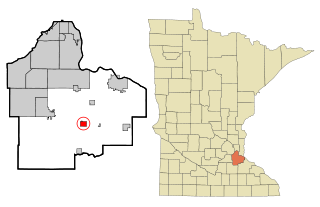Hill Lake Township is a township in Aitkin County, Minnesota, United States. The population was 430 as of the 2010 census.

East Bethel is a city in Anoka County, Minnesota, United States. The population was 11,786 at the 2020 census.

Ham Lake is a city in Anoka County, Minnesota, United States. It is a suburb in the Minneapolis–Saint Paul metropolitan area. The population was 15,296 at the 2010 census. It is in the Anoka-Hennepin School District, one of Minnesota's largest school districts.

Wyoming is a city in Chisago County, Minnesota. The population was 7,791 at the time of the 2010 census.
Jenkins Township is a township in Crow Wing County, Minnesota, United States. The population was 425 at the 2000 census.

Hampton is a city in Dakota County, Minnesota, United States. The population was 689 at the 2010 census.

Brandon is a city in Douglas County, Minnesota, United States. The population was 501 at the 2020 census.
Verona Township is a township in Faribault County, Minnesota, United States. The population was 391 at the 2000 census.
Oteneagen Township is a township in Itasca County, Minnesota, United States. The population was 310 at the 2010 census.
Chengwatana Township is a township in Pine County, Minnesota, United States. The population was 809 at the 2000 census. Chengwatana Township was organized in 1874. Its name is derived from the Ojibwe Zhingwaadena, applied originally to an Ojibwe village located at the confluence of the Snake River with the St. Croix River. Neighbouring Pine City Township and the City of Pine City get their names from the English translation of Chengwatana.
Pine City Township is a township in Pine County, Minnesota, United States, located south and east of the city of Pine City. The township population was 1,249 at the 2000 census.

McIntosh is a city in Polk County, Minnesota, United States. It is part of the Grand Forks, ND-MN Metropolitan Statistical Area. The population was 606 at the 2020 census.
Cannon City Township is a township in Rice County, Minnesota, United States. The population was 1,212 at the 2000 census.
Van Buren Township is a township in Saint Louis County, Minnesota, United States. It was named for Martin Van Buren, the eighth President of the United States. The population was 189 at the 2010 census.

Belgrade is a city in Stearns County, Minnesota, United States. The population was 740 at the 2010 census. It is part of the St. Cloud Metropolitan Statistical Area. Belgrade is home to the world's largest black Crow.
Brockway Township is a township in Stearns County, Minnesota, United States. The population was 2,702 at the 2010 census. The township includes the City of St. Stephen.
Holding Township is a township in Stearns County, Minnesota, United States. It includes the city of Holdingford. The township population was 1,139 at the 2010 census.
Millwood Township is a township in Stearns County, Minnesota, United States. The population was 972 at the 2010 census. The township includes the city of St. Rosa.
Sauk Centre Township is a township in Stearns County, Minnesota, United States. The population was 1,088 at the 2010 census.
St. Joseph Township is a township in Stearns County, Minnesota, United States. The population was 1,924 at the 2010 census. The township borders the western side of the cities of St. Cloud and Waite Park, and completely surrounds the city of St. Joseph. All are components of the St. Cloud Metropolitan Statistical Area.








